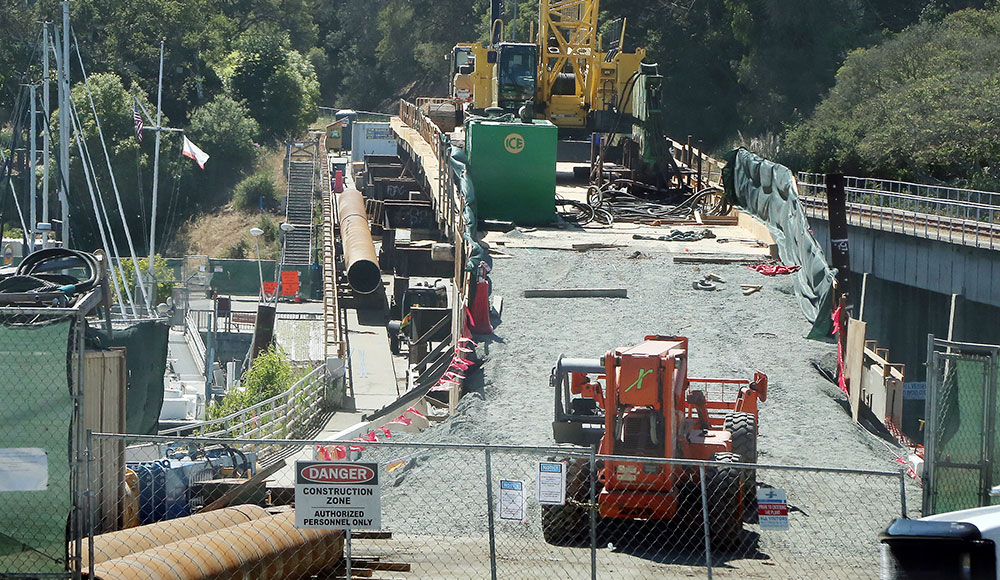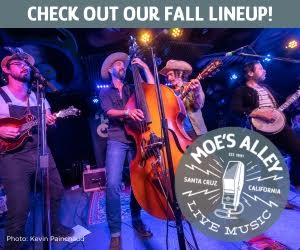For Santa Cruz businesses lucky enough to be close to the water, the summer months can bring tourist traffic—unless there are literally obstacles in the way.
In the harbor area, where a seismic retrofit project is closing Murray Street Bridge for months, local businesses have taken a big hit in revenue.
The westbound lane of the Murray Street Bridge has been closed since March. In June the entire bridge was shut down, with the lane expected to reopen in approximately seven months, although construction will remain active for at least three years.
Businesses on both sides of the bridge are feeling the repercussions, and they believe “the city has failed” them.
A possible solution surfaced at the end of July, when Patrice Boyle, owner of La Posta, a popular Italian restaurant on Seabright Avenue, started a petition to consider opening the adjacent rail bridge to foot and bike traffic.
For businesses in the area, help can’t come soon enough. Eric Taillan, a partner at Tramonti, an Italian restaurant on Seabright Avenue, says the closure has created a divide between the two sides of the harbor. “You’ll never push anyone from one side,” he says, “to drive thirty minutes in traffic from 4pm on to go to one place of business rather than staying on their side of town.”
Taillan fears for the future of Tramonti and the businesses and neighborhoods that surround it.
One of these is Betty Burgers, which has a shop just down the street from Tramonti, directly across from Murray Bridge. Laurie Negro, owner of Betty Burgers, says her Seabright Avenue location saw a drop of 20% in revenue when the bridge had one lane closed. Now that the entire bridge is inoperative, business is down 38% compared to last summer.
Negro is looking at closing the establishment two days a week and laying off staff during the winter. She says she has never considered taking these actions in the past. Negro is “very concerned about what happens in October,” when tourists from San Jose and elsewhere stop coming to Santa Cruz in great numbers. “That is when we are really going to feel it,” she says.
“I am really terrified,” says Brady’s Yacht Club owner Karen Madura. She has cut staff hours since bridge construction closed both lanes and has begun picking up shifts behind the bar. The business she is drawing in is equivalent to winter months. “Not having a spike in the summer is really nerve-racking,” she states.
Madura also worries about the length of the project and the long-term influences of the three-year closure. People are “creatures of habit,” she says. “Even if we survive this, if people haven’t been coming here for three years, it’s going to take a long time to get them back.”
All three business owners feel let down by local officials. They were given a couple weeks’ notice before construction began, and they saw tremendous changes to their revenue at the peak of summer. Negro claims that the city of Santa Cruz’s promises to fund promotional events and create clear and long-term signage have gone unfulfilled. The signage that exists now is bright orange with small black lettering and placed behind a chainlink fence.
In addition to the petition to open the railroad trail to bikes and pedestrians, business owners on both sides of the bridge have reached out with suggestions to open the bridge to traffic while it is not being worked on, and to exempt affected businesses from paying the district sales tax.
“I’d love to see the city fight for us, go to bat for us,” Madura says.
That may be happening after all. On Aug. 7, the Santa Cruz County Regional Transportation Commission gave the thumbs up to allow use of the Santa Cruz Rail Line Bridge for a potential temporary walking and biking path, as long as the city of Santa Cruz sought permission from the rail owner. At press time the Santa Cruz City Council was set to consider this course of action at its Aug. 12 meeting.














The MAJORITY of people accessing businesses by crossing over the bridge are doing so by AUTOMOBILE, not by foot or bike. Cyclists mostly take the safer Arana Gulch route. The BEST option to provide DRIVERS, Transit riders, cyclists and pedestrians from East to West and visa versa is to provide a RAIL SHUTTLE which could run from Capitola overlook to the Boardwalk. The SCC-RTC would need to repair the crossing guards for this to be feasible.
The last paragraph in this article is incorrect. The Santa Cruz County Regional Transportation Commission Staff said they would look into the possibility of a temporary foot/bike path on the rail bridge, they DID NOT give thumbs up. They know full well the implications of using the rail bridge run potentially all the way up to the Federal Level. This would likely require adverse abandonment and railbanking the line which is not viewed favorably by the STB, the Federal Authority overseeing such things. This process could take 3-7 years and still not be approved! Hence, a better option is to either 1-have a RAIL SHUTTLE or 2- have a frequent boat shuttle option. However, a BOAT SHUTTLE only gets people across the water – it does not get people from as far as Capitola or from the Boardwalk or downtown.
The RTC was urged to consider investing in a rail shuttle at least 2 years prior to this closure. Providing a foot bridge will not increase business to the extent these restaurants are suggesting since people are mostly tied to their cars. This is an opportunity to help local businesses and get people using transit and we hope the RTC will seriously consider a rail shuttle which can bring people to these businesses and even closer to work from rather distances.
It’s interesting that the one immediate solution (opening the Murray St rail brdidge to bikes and pedestrians) UNANIMOUSLY adopted by both the Regional Transportation Commission and the Santa Cruz City Council is rejected by Lani Faulkner. Stay the course, open the rail bridge, and provide immediate relief to the struggling businesses in the Seabright and harbor neighborhoods. Rather than “knowing better” what is best for the Seabright and harbor businesses, perhaps Ms Faulkner should listen to what they are saying.
Lani, the rail trolley proposal simply isn’t feasible in the near term. Even under the best circumstances, it would take years of planning, permitting, funding, and construction before it could serve anyone—time that struggling businesses simply don’t have.
Adverse abandonment is not required to provide relief now. What’s needed is for Progressive Rail and Roaring Camp to allow temporary access across the tracks during the Murray Street bridge construction. This could happen quickly if all parties are willing to cooperate.
And let’s be clear—this is only part of a temporary solution. We should also be increasing public transit service into the harbor area and providing tax relief for affected businesses until the bridge work is complete.
Lani proposes “pseudo-solutions” that will offer no immediate benefit to these businesses. The object here is to get the best even partial solution in place quickest. If Lani wants to promote a “trolly” on the out of service tracks and bridges, that’s a proposal for another time and place. This is the time to stay focussed on the goal at hand – to benefit our community’s businesses.
Perhaps Ms. Faulkner mis-heard my statements at both the RTC and City Council meetings: we (the small businesses in lower Seabright and the harbor) need ALL the traffic – pedestrians, bikes, bus riders, and cars. While cars are the predominant mode of travel; it is getting everyone into Seabright that makes us whole and solvent, small business owners know this.
This is an opportunity to get people using alternate transit, we agree on that. Walking and bicycles ARE alternate, inexpensive, transit that can happen FAST.
Also, we need the FASTEST way of enacting ALL of the proposals in order to headoff runiation for us.
PLEASE, lets get this done now.
Lani often criticizes “car-centric” thinking, yes a majorty of people that access the business do so my car, but a lot of people are not biking around town. With more Bcycles stations out there, access to peddal assist bikes is booming!
Cyclists aren’t bypassing the bridge because they love detours like Arana Gulch, they take it because it’s the only safe option now. What cyclists actually want is the safest, fastest, straightest, most direct route, and a continuous connection across the bridge would finally give us that. The same direct path would also benefit pedestrians, opening up the ability to park in the harbor and walk to Seabright, or park in Seabright and walk to the harbor, without detours or unsafe crossings.
Some have suggested a “rail shuttle” as the answer. In reality, this idea has serious flaws:
It would require temporary stations to be built, each of which must meet ADA accessibility requirements, adding time, cost, and complexity.
On a single-track line, shuttles would be unable to pass each other, creating a slow, rigid schedule that serves far fewer people than a direct walking/biking path.
The cost of repairing crossing guards, maintaining vehicles, and staffing operations would be ongoing, all for a service that still leaves passengers needing other transportation to actually reach their final destinations.
By contrast, a continuous bike/pedestrian connection across the bridge is a one-time investment that works for everyone, cyclists, pedestrians, and even those arriving by car who want to walk from a nearby lot.
If the goal is truly to support local businesses and improve accessibility for everyone, the focus should be on direct, continuous bike and pedestrian access, not on pouring resources into an overcomplicated, ADA-challenged rail shuttle that can’t even pass itself on the track.
How quickly adverse abandonment or railbanking can happen, especially in emergency or expedited cases. 6-12 monts not 3-7 years!
Mechanisms That Accelerate the Process
Public Use Condition (PUC)
When a rail line is approved for abandonment, the STB can issue a Public Use Condition (PUC). This temporarily prohibits disposal of infrastructure like bridges or culverts for 180 days, giving trail sponsors breathing room to prepare a railbanking proposal.
A third party such as a public agency can file an adverse abandonment request, asking the STB to declare a line abandoned even if the railroad doesn’t intend to do so. This can speed up the legal separation of the corridor from the national rail system.
The STB’s rules (49 CFR Part 1152) govern the abandonment and discontinuance process, which generally takes longer than six months due to required notifications, comment periods, and potential extensions.
“In theory, the STB’s Public Use Condition alone can buy a trail sponsor up to 180 days to organize, negotiate, or file for railbanking after abandonment is approved and a third party could file an adverse abandonment petition to accelerate legal separation
Rails to Trails Conservancy
In the most streamlined cases, the process might be completed in as little as six months under emergency conditions, but that would require perfect coordination, immediate filing, and no legal resistance.”
One solution I see is to re-open) bring back all four lanes on both Soquel Avenue and Capitola Road since these two arteries seem to be impacted the most with impossible traffic.
The bridge had to be repaired. There are three confounding problems.
1) The coastal commission has this insane idea that seagulls and pigeons can’t be disturbed. Neither are endangered, yet outrageous restrictions are placed on construction projects causing massive delays – probably doubles the construction times and certainly delayed the start and massively increased the costs. Now add the communities failing business cost to this. This issue is the root cause of why the wharf was destroyed.
2) The train is a fantasy – it will sit there unused for eternity. The RTC leadership should be fired for initially claiming a $1B’ish dollar project is actually $5B’ish. 100’s of millions in studies later and millions more in studies that they have no idea how to pay for – the train advocates claim free money from uncle sam will fall out of the sky to pay for everything for a transportation project that marginally benefits a tiny fraction of the population. This is corruption and incompetent management at its finest. Let me do the math for you. $5B divided by the counties population of 250,000 persons is $20,000 each. That doesn’t even include the on-going operational expense. Now observe that the profit from these construction projects are easily 20% – so every man, woman, and child going to pay $4,000 to some small collection of individuals running the show to pocket. Its obviously corrupt.
3) The cities and counties political apparatus lacks the common sense to sort this out and in fact can’t clearly confront the reality of item #1 and #2.
I suggest:
The county should immediately vote to tax itself 2-4% to pay for the train, or rail bank it waiting for a prosperous future where money actually does fall from the sky a 100 years from now. That way we can actually make use of the existing bridges and paths that connect our communities now. Sorry, but rail/trail fails in so many places where the corridor can’t be shared. Look at the bike trail in Monterrey to Castroville – where is works and where it doesn’t. If you didn’t know, Santa Cruz has some of the highest bicycle fatality/injury rates in the state. Fail.
The coastal commission should be sued and held accountable for our losses for their insanity in insisting that pidgeons and seagulls cannot be disturbed. I love the pideons and seagulls, but displacing/relocating them with care is just common sense.
RTC leadership should embrace facts and cost begin telling the truth or resign.
And by the way – it would be great to know why CALTRANS refused to endorse the changes to hiway 1 designed by the RTC. What I read is that CalTrans was unwilling to publicly criticize the RTC plans but would not endorse it either – presumably because it lacked common sense and the plans that CalTrans favored would have created significant additional capacity on hiway 1. Be great to know what CalTrans favored plan would have done relative to the Trains overly optimistic impact.
Not crying for the diminished business at BB – it seems that in the past, they would “pre-cook” their product – yuck.
No mention of the substandard Seabright Social’s closure. Tramonti gets my biz due to stellar menu and decent service, On the other side of the menu options/service level is PB’s LaPosta where the acoustics of the interior make having a relaxed experience/conversation nearly intolerable. Just my opinions and I’m sticking to them.
ps
I am NOT checking the box to opt in to receive the newsletter – publisher: please honor that !